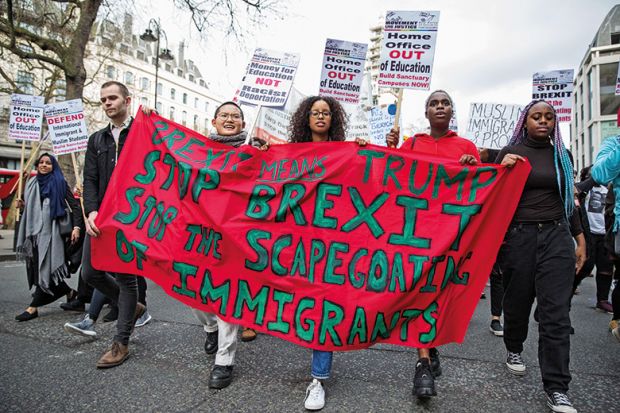When Theresa May confirmed last week that the Conservative pledge to cut net migration to the “tens of thousands” would feature in the party’s election manifesto, she claimed that Brexit would help her to achieve the aim.
“When we leave the European Union, we will have the opportunity to make sure we have control of our borders – leaving the EU means we won’t have free movement as it has been in the past,” she told journalists at a campaign event in London.
A reduction in the number of students coming from the Continent might be key to the government’s mission, given that the prime minister continues to ignore calls from universities and Conservative colleagues to remove students from the target.
Data released by the Office for National Statistics earlier this year revealed that a drop of 41,000 in the number of international students coming to the UK in the year ended September 2016 was the major factor accounting for net migration’s falling to its lowest level since 2014, although the majority of this decline occurred among non-EU students.
Ryan Shorthouse, chief executive of Bright Blue, a thinktank and pressure group for liberal conservatism, said that there was a “siege mentality” among senior government figures over the inclusion of students in the target and that Ms May wanted to “maintain the image of being someone who doesn’t back down easily and stands up to vested interests”.
He said that introducing a cap on the number of student visas was one possible route the government might take, even though it has repeatedly insisted that there is no limit on the number of genuine overseas students who can come to the UK.
“That could be something that they look into because obviously to achieve the tens of thousands target, you do need to clamp down on every part of the immigration system,” he said.
Another potential method of deterring students could be to reduce the four-month period that they are allowed to remain in the UK after completing their studies, he said.
Last year, Amber Rudd, the home secretary, said that the government would consult on changes that would introduce tougher rules for overseas students entering the UK to enrol on “low-quality” courses and would instead prioritise the “best” universities, although the plans appear to have been dropped for the time being, given that the promised consultation is yet to appear.
Mr Shorthouse was doubtful about whether that specific proposal would return, but he said that there was still a “mentality” within No 10 that there are “different types of students” and that the UK should welcome only “the brightest and best”.
He predicted that the government’s main strategy would be to demand that universities monitor much more closely “the genuineness of people who have sponsored visas with that institution”. Universities are currently at risk of losing their licence to recruit overseas students if 10 per cent of their prospective overseas intake are refused visas.
But Colin Riordan, vice-chancellor of Cardiff University and a member of Universities UK's International Policy Network, said that the argument to remove students from the migration target was “not really worth pursuing”, suggesting that the government would focus on other sectors in its battle to reduce immigration.
“It’s a bit of a red herring because what will transpire is that students don’t actually significantly contribute to [net migration], the numbers of students coming here from the EU will go down [post-Brexit] and the government will have other levers to affect migration once we’ve left the EU,” he said.
What universities should do instead, he argued, is press the government for the introduction of post-study work visas, for the creation of visas for specific regions of the UK, and for ways to “improve the experience” for prospective international students in the visa application process.
But Mr Shorthouse suggested that UK universities’ protests over Conservative policies, such as the teaching excellence framework and plans for universities to run schools, might have weakened their influence among senior government figures.
“My feeling is that a lot of people in No 10 feel that there has been a lot of complaining that has been unjustified and exaggerated from the university sector,” he said.
“With the current crop of No 10 advisers…universities have to think more critically about when they criticise and when they get behind the government.”
The continued inclusion of students in the UK’s migration target, if it maintains downward pressure on numbers, might boost international student traffic to the US, Canada and Australia.
Kareem El-Assal, research associate in education and immigration at the Conference Board of Canada thinktank, has first-hand experience of the UK’s tough visa regime. He was forced to leave the country after completing a master’s in the UK in 2012 when the post-study work route, which had allowed students two years to seek employment after their course ended, was closed.
“The advantage for Canada is our open immigration system,” he said. “Given what’s occurring in the UK, I think it is going to work in our favour.”
Register to continue
Why register?
- Registration is free and only takes a moment
- Once registered, you can read 3 articles a month
- Sign up for our newsletter
Subscribe
Or subscribe for unlimited access to:
- Unlimited access to news, views, insights & reviews
- Digital editions
- Digital access to THE’s university and college rankings analysis
Already registered or a current subscriber? Login










